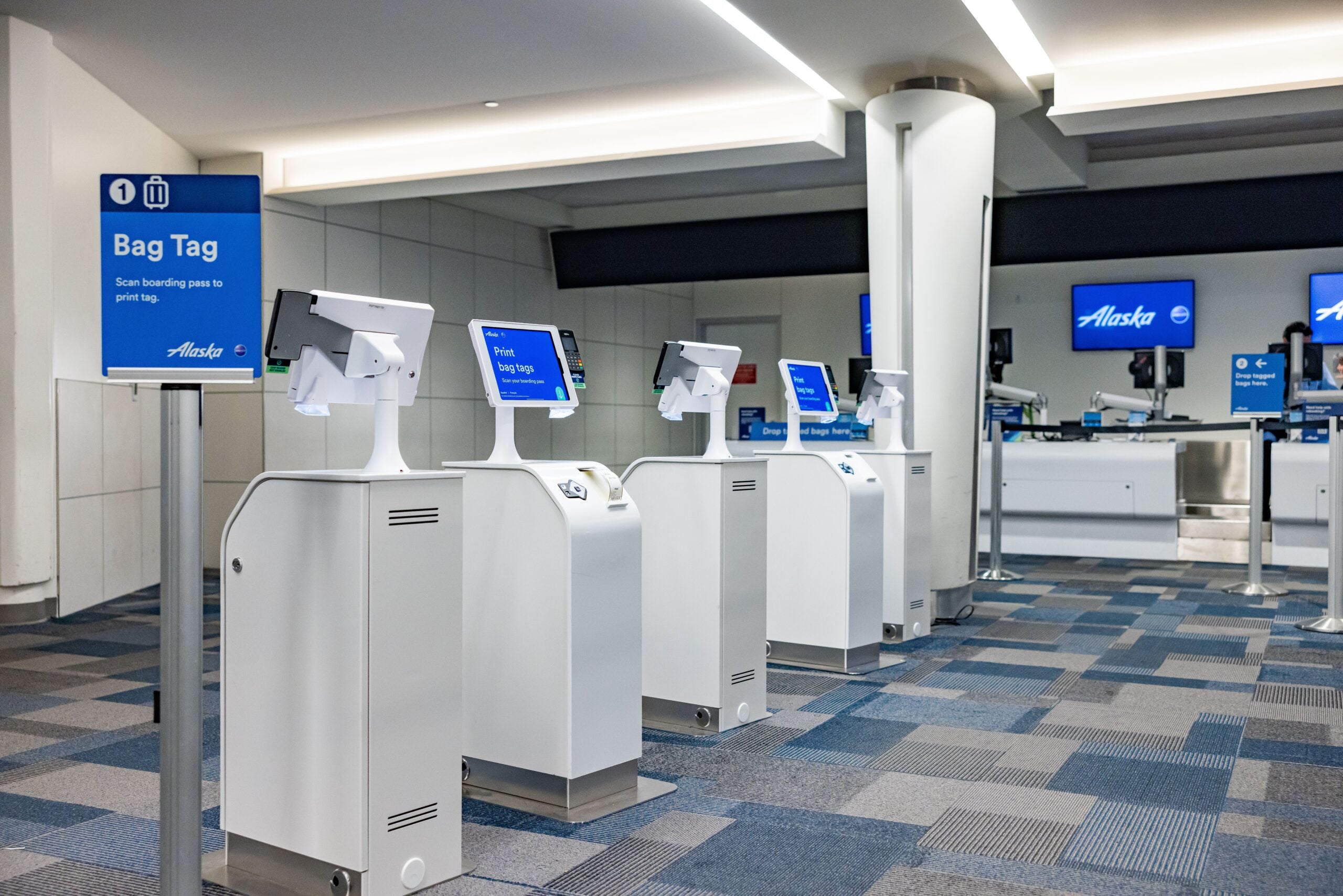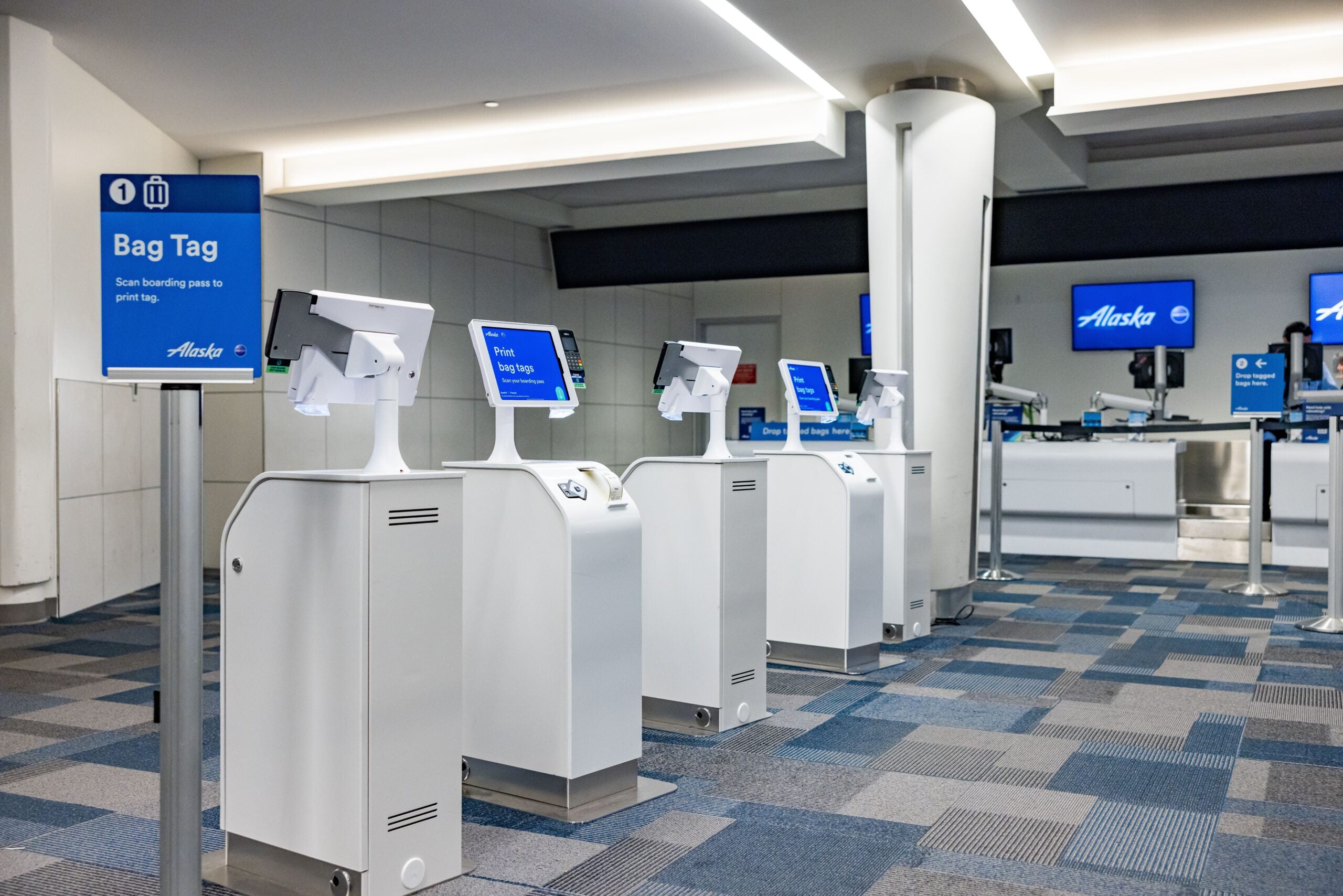No more check-in kiosks. Pristine white iPad bag tag printers and automated baggage drop stations will soon greet Alaska Airlines customers as they make their way through the airport.
Alaska’s futuristic and minimalistic new look is part of a slate of airport lobby upgrades the carrier is taking to streamline its check-in process. The upgrades are part of a $2.3 billion investment into infrastructure upgrades at key airports.
Charu Jain, Alaska’s senior vice president of merchandising and innovation, said the Seattle-based carrier had been looking for ways to improve the customer experience at airports — such as trying to slash long lines at check-in kiosks and the eliminate hassle of finding an agent to weigh and place a tag on checked-in luggage.
Want more airline-specific news? Sign up for TPG’s free biweekly Aviation newsletter.
The airline conducted studies on its passenger experience and found that the lobby was one of the bigger sore points for passengers, an additional obstacle for customers to clear before getting through security.
“The lobby appeared to be the area where there was a lot of anxiety around — ‘Well, how much time is it going to take me?’” Jain said. “‘Am I going to miss my flight because I have to now get in line to see an agent.’”

One of Alaska’s most-notable upgrades includes removing self-serve kiosks that print boarding passes. With the change, passengers will be steered toward either printing their boarding passes at home or downloading them onto their phones.
However, if there are passengers who want a printed boarding pass at the airport, an agent will be able to print one for them, Jain said.
Passengers flying through Oregon’s Portland International Airport (PDX) already got a taste of Alaska’s kiosk-less lobbies, where printed boarding passes are almost a relic of the past. In addition to Portland, the carrier has also already removed the self-service kiosks at airports in Las Vegas; Indianapolis; Cleveland; Missoula, Montana; and Boise, Idaho.
Still, an Alaska Airlines spokesperson said approximately 80% of its customers arrive at the airport with a mobile boarding pass or one that they printed at home.
Jain added that the carrier has seen minimal resistance to the new measure from passengers, even from older flyers who may not be as technologically savvy.
“We’re actually finding that people are reading their emails — the older passengers read their emails and follow instructions, so they’re coming better prepared to the airport,” Jain said.
Another one of Alaska’s upgrades will allow customers to print their bag tags with iPads mounted onto stands by scanning their boarding passes.
Alaska will also start implementing automated bag drop stations. Flyers will be able to weigh and drop off their baggage on their own rather than having a customer service agent handle baggage.

Instead of an agent checking passengers’ IDs before placing their luggage onto the conveyor belt, Alaska will use biometrics to scan for travelers’ faces as they drop off their bags. However, just as is the case with the boarding passes, agents are still available to handle baggage if that’s what passengers prefer, Jain said.
While Alaska’s upgrades digitize much of the process of checking in, almost eliminating the core job responsibilities for check-in agents, Jain said the carrier does not plan to cut any jobs. Instead, those agents will instead focus more on customer service.
“Say, rather than doing a transactional thing like scanning a bag tag for every single passenger, spend your time with the guests that need the help,” Jain said. “So families or people that really need or want to talk to an agent and go through everything with an agent. They have that choice.”
Previously: Alaska Airlines quietly cuts inflight entertainment tablets
These upgrades went through a test run at the San Jose Mineta International Airport (SJC) in California throughout the past year, where passengers had the opportunity to test out the technology.
Automated baggage drops are next scheduled to come to Alaska’s hubs in Anchorage, Alaska, Los Angeles, San Francisco and Portland. Jain said all of Alaska’s locations will have the new bag tag stations and self-service kiosks will be removed.
She added that Alaska’s smaller bases may not need the automated baggage drop.
“We will start with our hubs and then evaluate which other stations we should put that at,” Jain said. “
Jain lauded the new upgrades, saying much of the technology Alaska used in its lobbies was at least 25 years old.
“The time has come to say people have changed behavior, guests have changed behavior, they’re expecting things to be faster,” she said.



